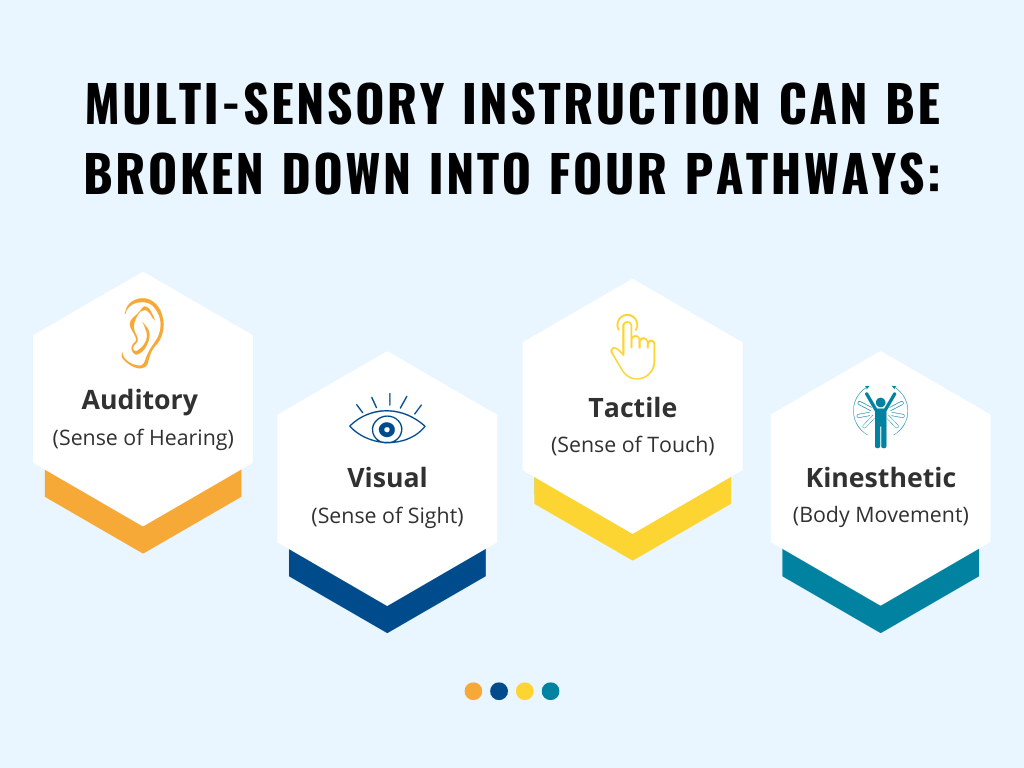5 Multisensory Orton-Gillingham Activities to Use in the Classroom
By bringing Orton-Gillingham strategies into your classroom, you create endless opportunities for your students.

For every student, one of the modalities mentioned in the image above is usually predominant. Some students may prefer to see a visual representation of an image to grasp it, while others may choose to use their hands.
According to Dr. Samuel Orton’s research, brain dominance significantly impacts learning to read. Both hemispheres of the brain act and react, think and process, and solve problems in their own specific and quite different ways, and one side is usually dominant.
A student can capitalize on their strengths and strengthen their weaknesses when all four learning pathways are utilized within a lesson. Educators also have a higher chance of students grasping the concept during initial instruction.
Many believe the Orton-Gillingham approach is only beneficial in special education or reading intervention, but that is just not the case. Orton-Gillingham is for all students.
Multisensory Orton-Gillingham Activities
Every student learns at their own pace, but when multisensory (also known as multimodal) strategies are utilized, students are given the opportunity to reach their full potential through various delivery styles.
Check out these five activities that you can begin using in your classroom today!
Read it, Build it, Write it
Consider using this Orton-Gillingham activity when teaching Red Words or irregular words (i.e. ‘does’ or ‘was’). Students need to be able to master these words that do not fit the expected spelling patterns.
Start by giving each student a sheet of paper with three boxes on it with the labels “Read It,” “Build It,” and “Write It.” Additionally, you should provide your students with Red Word flashcards, block or magnetic letters, and a pencil or crayon.
Read the irregular words in the “Read It” box aloud with your students. Students are then asked to identify what makes the word irregular and what is unexpected in the spelling pattern. Students should then use the block or magnetic letters to build out the word in the “Build It” box. Once they successfully build it out, the students should write it in the “Write It” box.
Writing in Shaving Cream or Sand
This Orton-Gillingham activity utilizes visual, auditory, and tactile (fine motor) pathways. Take a plastic tray, cookie sheet, tabletop, or other medium and cover them with shaving cream or sand. Call out a known sound and have your students repeat the sound. Then they should use their fingers to write the letter that makes that sound while verbalizing the letter name and sound (/d/ d says /d/). By utilizing their fingers to write the letter, they are accessing thousands of nerve endings that transfer patterns to the brain.
You can also use this strategy for whole words, but be sure they are phonetic words that follow expected spelling patterns.
Writing in the Air
This Orton-Gillingham activity is similar to the shaving cream or sand activity but instead uses kinesthetic (gross motor) pathways. Utilize muscle memory to reinforce the letter and sound each letter makes through air writing.
Your students should use their dominant arm for this activity and move from the shoulder to promote large muscle movement. As the students write the letter in the air, have them visualize it in a specific color while verbalizing the letter name and sound.
Arm Tapping
This Orton-Gillingham activity helps students master irregular words through multisensory review.
Start this activity with a stack of cards containing the words your students are learning. State the words one by one while holding the card, with your non-dominant hand, in front of you. Ensure your students can see the word by making sure the card is at eye level with them.
Have students tap left to right using their dominant hand. Right-handed students start with their right hand on their left shoulder, and left-handed students start with their left hand on their right wrist. State each letter of the word while your students tap down their arms, and once they tap out each letter, state the whole word while creating a sweeping motion down the arm. Think of this sweeping motion as underlining the word.
Blending Boards
Blending boards can be used to prepare students for decoding multisyllabic words. Blending boards help with the practice of segmenting sounds and blending those sounds into syllables.
Take phoneme cards and place them in CVC (consonant vowel consonant) order on the blending board. Place your hand over each card while your students sound them out, and once they state each sound, sweep your hands across the board and have your students state the word or syllable.
You can use VC patterns or start with a continuant sound versus a stopped sound with students who struggle.
Additional Resources
Bringing Orton-Gillingham strategies into your classroom creates endless opportunities for your students. For more insights and strategies, visit the links below:
- Search “Orton-Gillingham Activities” or “Multi-sensory Activities” on Pinterest to find hundreds of exciting ideas you can implement in your classroom immediately.
- Check out the IMSE YouTube Channel, where you’ll find several helpful videos about teaching open and closed syllables, three-part writing drills, and more!
